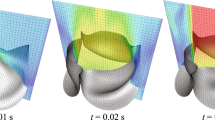Abstract
The present article deals with fictitious domain methods for numerical realization of scalar variational inequalities with the Signorini type conditions on the boundary. Two variants are introduced and analyzed. A discretization is done by finite elements. It leads to a system of non-smooth, piecewise linear equations. This system is solved by the semismooth Newton method. Numerical experiments confirm the efficiency of this approach.
Similar content being viewed by others
Explore related subjects
Discover the latest articles, news and stories from top researchers in related subjects.References
Benzi M, Golub GH, Liesen J (2005) Numerical solution of saddle point systems. Acta Numer 1–137
Brezis H (1972) Problèmes unilatéraux. J Math Pure Appl 51: 1–168
Chen X, Nashed Z, Qi L (2000) Smoothing methods and semismooth methods for nondifferentiable operator equation. SIAM J Numer Anal 38: 1200–1216
Facchinei F, Pang J-S (2003) Finite-dimensional variational inequalities and Complementarity problems. Springer, New York
Farhat C, Mandel J, Roux F (1994) Optimal convergence properties of the FETI domain decomposition method. Comput Methods Appl Mech Eng 115: 365–385
Girault V, Glowinski R (1995) Error analysis of a fictitious domain method applied to a Dirichlet problem. Jpn J Indust Appl Math 12: 487–514
Glowinski R, Pan T, Periaux J (1994) A fictitious domain method for Dirichlet problem and applications. Comput Methods Appl Mech Eng 111: 283–303
Haslinger J, Klarbring A (1995) Fictitious domain/mixed finite element approach for a class of optimal shape design problems. M2AN 29: 815–834
Haslinger J, Kozubek T (2000) A fictitious domain approach for a class of Neumann boundary value problems with applications in shape optimization. East-West J Numer Math 8: 1–26
Haslinger J, Kozubek T, Kučera R, Peichl G (2007) Projected Schur complement method for solving non-symmetric systems arising from a smooth fictitious domain approach. Lin Algebra Appl 14: 713–739
Ito K, Kunisch K (2003) Semi-smooth methods for variational inequalities of the first kind. M2AN 37: 41–62
Kronsjö L, Dahlquist G (1972) On the design of nested iterations for elliptic difference equations. BIT Numer Math 12: 63–71
Kučera R (2005) Complexity of an algorithm for solving saddle-point systems with singular blocks arising in wavelet-Galerkin discretizations. Appl Math 50: 291–308
Van der Vorst HA (1992) BiCGSTAB: a fast and smoothly converging variant of BiCG for solution of nonsymmetric linear systems. SIAM J Sci Statist Comput 13: 631–644
Zhu Q (1998) A survey of superconvergence techniques in finite element methods. Lect Notes Pure Appl Math Ser 196: 287–302
Author information
Authors and Affiliations
Corresponding author
Rights and permissions
About this article
Cite this article
Haslinger, J., Kozubek, T. & Kučera, R. Fictitious domain formulations of unilateral problems: analysis and algorithms. Computing 84, 69–96 (2009). https://doi.org/10.1007/s00607-009-0026-y
Received:
Accepted:
Published:
Issue Date:
DOI: https://doi.org/10.1007/s00607-009-0026-y



